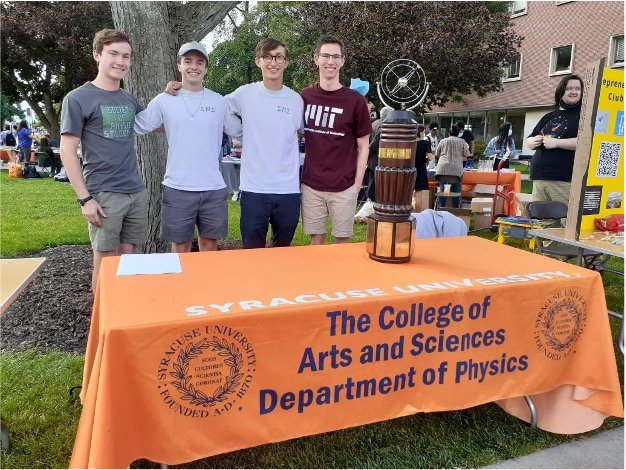
As leaders of the Society of Physics Students (SPS), Matthew Cufari ‘23 and Daniel Paradiso ‘22 have worked to build a better undergraduate community in our department. Lured in by the promise of new friends and free pizza, Matt and Daniel enjoyed the organization and the community it served. They both stuck around, and today they are, respectively, the President and Vice President of SPS. It is fitting that they ended up in these leadership positions together, as they share both a childhood rooted in New York state and a long-standing passion for science that has led them to become undergraduate leaders in our department.
Matt was born and raised in a suburb of Rochester called Pittsford. He was interested in science during his high school years, which led him to participate in a summer research experience at the Laboratory for Laser Energetics at the University of Rochester. It was through this program that Matt narrowed his interest and decided to pursue a career in physics. Even before the summer at University of Rochester, Matt was a driven scholar, as demonstrated by earning the Coronat Scholarship to Syracuse University. With this scholarship and a family history of attending, Matt enrolled in a double major in physics and computer science.
Daniel grew up in Watkins Glen, just an hour and a half drive south of Rochester. Similar to Matt, Daniel always enjoyed his math and science courses in elementary and high school. He also had a family history of attending Syracuse University and liked its proximity to home, so enrolling was an easy decision. However, he was not laser-focused on physics upon entering Syracuse, and began his college career as an aerospace engineering major. The experience of taking an electricity and magnetism course with Professor Jay Hubisz and Graduate TA Bharath Sambasivam caused Daniel to reconsider his major. He found the problem solving nature of physics stimulating, and appreciated the great teachers in the department. Daniel was convinced, and switched his major to physics.
Given their similar backgrounds, it is perhaps unsurprising to learn that they share an appreciation for quantum physics. When asked about which class was his favorite, Matt responded, “[My] favorite class thus far was Introduction to Quantum Mechanics with Professor Stone. Even though the class was taught online, and the workload was intense, to say the least, the problems we tackled were exciting and just the right amount of challenging.” Daniel’s response was similar. “I really enjoyed my classes that were related to quantum physics… Last semester I took Quantum Information Science with Professor Hubisz and found it challenging but it is probably the most fun physics course I have taken so far. Now, I am taking Quantum I with Professor Hubisz and I’m loving it so far!”
As the leaders of SPS after the worst of the pandemic, Matt and Daniel are reigniting the warm sense of community through new in-person events. They are also working to take part in outreach efforts with the local community. Matt is most proud of their work organizing a yearly northeast SPS research symposium, which is for undergraduate students from institutions across the northeast. Not only were they able to organize the symposium, but Matt and Daniel could participate as well. They both have been involved in research with faculty in their time at Syracuse - Matt has done work with astrophysics Professor Eric Coughlin while Daniel has done work with neutrino Professors Mitchell Soderberg and Denver Whittington.
Matt’s research with Dr. Coughlin is centered around Tidal Disruption Events (TDEs). A TDE is when a star’s orbit around a much more massive black hole shrinks and the star gets too close, where the gravitational forces rip the star apart. Matt's research on the ultimate fate of the tidally disrupted star found that the eccentricity of the orbit is crucial to predicting whether or not the star is completely torn apart, and what will happen to the remnant material of the star if it is. Matt and Dr. Coughlin’s research into TDEs has been approved for publication in The Astrophysical Journal.
Daniel began doing research with the neutrino group in the lab of Dr. Soderberg in just his second year at Syracuse, shortly after switching his major. Daniel is very grateful for the working relationship he and Dr. Soderberg forged while conducting research together, “Although Mitch is my research advisor, he is also someone that I go to when I need advice for something such as what classes I should be taking or also help on my graduate applications.” Today Daniel is working in Dr. Whittington’s group alongside graduate student Hilary Utaegbulam, where they are constructing an array of plastic scintillator detectors for tagging muons produced by cosmic rays. Daniel’s work is focused on developing code to collect data and a user interface that will simulate detections in real time.
Matt and Daniel both intend to carry on their careers in physics by pursuing a PhD upon graduation. After working with Dr. Coughlin on TDEs, Matt wants to continue doing theoretical astrophysics in his graduate program. Daniel is looking to find a graduate program that will keep him in observational astronomy; whether he will continue observing neutrinos, or something different like light or gravitational waves is yet to be determined. Both Matt and Daniel have expressed a desire to conduct their own research and their own classrooms once they earn their graduate degrees. “I’m interested in staying in academia because my long-term career interests are in research and teaching,” said Matt. Daniel similarly remarked, “Being able to do research of my own is a goal of mine and having the opportunity to teach is something that is appealing to me. As someone who has had nothing but good experiences with physics professors, I would like to be able to do that for the future generations of physics students.”
